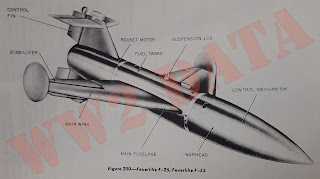German Explosives
Taifun Bi-Liquid Rocket
General
The rocket Taifun is a biliquid rocket reputed to be fired in groups of 65 from a launching machine known as the Dobgerate. From all indications, it never passed beyond the experimental stage.
The projectile is approximately 2.1 meters long and 10 centimeters in diameter. The greater part is taken up with the fuel tanks which contain Visol and acid. The acid is housed in a central aluminum tank, while the Visol is contained in the annular tank between the inside tank and the outer skin of the missile. The walls of both tanks are 1 mm thick.
The acid tank is supported in the rocket shell by two aluminum end plates bolted to its end flanges. These end plates are perforated so as to connect the fuel tanks at the upper end to the cartridge pot, and at the lower end to the liquid sprays. A thin aluminum rupturing diaphragm covers the holes in the two end plates.
Behind the solid steel nose piece there is a hollow chamber for housing the 500 grams of explosive, the impact fuze, and the igniting device for setting off the cartridge pot.
The cartridge pot is just aft the chamber which houses the warhead and the fuzing system. When the contents of the cartridge pot begin to burn, a gas is generated which is used to expel the liquids from the tanks and force them into the combustion chamber.
The combustion chamber and venturi are made of mild steel mostly 1 mm thick, but the thickness increases at the venturi throat to 2 and 1/2 to 3 mm. At the end of 2 seconds operation, the temperature of the venturi reached 300 degrees to 400 degrees. It was possible to use a venturi experimentally for five runs, after which it had to be renewed.
Data
Dimensions
Total Length: 2.1 meters
Maximum Diameter: 0.1 meters
Length of Tanks:
-Acid Tank: 1.15 meters
-Annular Tank: 1.2 meters
Diameter of Tanks:
-Acid Tank: 0.08 meters
-Annular Tank: 0.1 meters
Weights
Nose Piece: 1.3 kilograms
Outer Shell: 3.25 kilograms
Tanks: 1.75 kilograms
Combustion Chamber: 1.5 kilograms
Thrust Block: 0.73 kilograms
Thrust Disk: 0.7 kilograms
Rest: 1.77 kilograms
Total (Empty): 11 kilograms
Charge in Warhead: 0.5 kilograms
Expellant Cartridge: 0.5 kilograms
Acid: 8.6 kilograms
Fuel (Vizol): 2.3 kilograms
Total (Loaded): 22.9 kilograms
Feuerlilie Model F-25
Description
The F-25 is one of the "Feuerlilie" series of rocket-propelled guided missile which the LFA (Luftahrtforschungsanstalt Herman Goering E.V.) located at Volkenrode/Braunschweig, Germany, was developing in order to obtain aerodynamic data in the near sonic and supersonic regions. Although the primary purpose of the Feuerlilie series development was to obtain aerodynamic data, some thought was also being given to the possibility of using certain models, such as the F-25, for actual production as a weapon of war.
This model has a fuselage 2 meters in length and 25 cm maximum diameter with two wings attached to the midbody. The main wing span is 112 cm. The rocket drive is of the solid propellant type. The F-25 was a ground-launched rocket, which could reach an altitude of 3,000 meters with a horizontal range of 5,000 meters.
History of Development
Development work on the F-25 was started in the spring of 1943 by Dr. Gerhard Braun of LFA. The fuselage was built by the Ardelt Werke, located in Breslay. About 20 models were built, of which 10 or more were tested successfully at Leba, near the Ostsee in Pomerania. However, the low maximum speed of 220 meters per second makes the result of no great significance. Development work was stopped in the fall of 1944.
Conclusions
Since the Feuerlilie F-25 was primarily a research project, it is of interest from a historical standpoint only.
Details
Airframe
The airframe of the F-25 consists of a 2-meter fuselage to which two main wings are attached near the mid body. The wings are provided with ailerons to give roll stabilization in flight.
Power Plant
The power plant used for F-25 is of the solid propellant type RI 502 and was built by Rheinmetall-Borsig.
Design Data
Weight of propellant: 17.5 kilograms
Burning Time: 6 seconds
Thrust: 500 kilograms
Total Weight of Missile: 115 kilograms
To produce an even thrust for aerodynamic data purposes, a blowoff valve located between the two venturis is provided. This valve opens at a pressure of 100 atmos.
Control System
The roll stabilization system used for F-25 was the same as that used for Hecht; i.e. one gyro was installed with its axis perpendicular to the missile axis in such a way as to increase the effective moment of inertia of the missile in roll. If a disturbance sets up a roll moment, the gyro would tend to precess, which would in turn cause the ailerons to reverse the roll of the missile. When no damping was provided with this system, excessive roll occurred. A mechanical dash-pot was added to remedy this condition.
The main reason for the choice of this type of gyro control was that the weight and space requirements were less than for the conventional available auto-pilot devices. The gyros were procured from Kreiselgerat, Berlin.
No attempt was made to remotely control the flight of Feuerlilie F-25.
Warhead and Fuzing
Since the F-25 was only a test model, no warhead was provided. A Rheinmetall-Borsig time fuze was used to ignite the flares mounted on the wing tips to insure satisfactory tracking of missile in flight.
Launching
The F-25 was launched from the ground at an angle of 10 degrees to 30 degrees to the vertical.
Next Time: Rockets (Part 10)
Source: German Explosive Ordnance Vol. 1: Bombs, Rockets, Grenades, Mines, Fuzes & Igniters


No comments:
Post a Comment